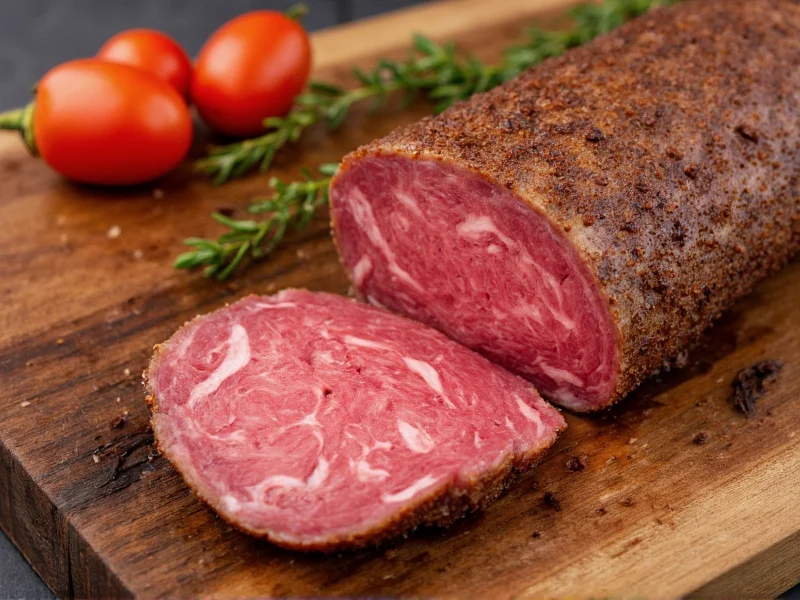A pastrami rub is a dry spice mixture primarily composed of black pepper, coriander, garlic, mustard seed, and paprika, traditionally used to flavor and preserve brisket before smoking. The ideal ratio combines 2 parts coarse black pepper to 1 part coriander seed with supporting spices, creating the distinctive flavor profile associated with authentic New York-style pastrami.
The Essential Guide to Crafting Authentic Pastrami Rub
Creating the perfect pastrami rub requires understanding both the science and tradition behind this iconic deli staple. While many commercial blends exist, homemade pastrami seasoning offers superior flavor control and authenticity. The magic happens when the right combination of spices penetrates the meat during the curing process, transforming ordinary brisket into that distinctive pink-hued, flavorful pastrami we all love.Core Components of a Traditional Pastrami Rub
The foundation of any quality pastrami rub consists of five essential elements, each serving a specific purpose in the curing and flavor development process:| Spice | Primary Function | Flavor Contribution |
|---|---|---|
| Coarse Black Pepper | Antimicrobial properties, texture | Pungent, sharp heat |
| Coriander Seed | Flavor enhancer, tenderizer | Citrusy, floral notes |
| Garlic Powder | Flavor depth, aroma | Savory umami base |
| Mustard Seed | Emulsifier, flavor complexity | Sharp, tangy undertones |
| Paprika | Color development, mild sweetness | Earthy, slightly sweet |
Traditional New York Style Pastrami Rub Recipe
This authentic deli-style pastrami seasoning blend yields enough for a standard 10-12 pound brisket. For best results, freshly grind whole spices rather than using pre-ground versions. Ingredients:- 1 cup coarse black pepper (freshly cracked)
- ½ cup coriander seeds (toasted and ground)
- ¼ cup garlic powder
- ¼ cup mustard seeds (yellow or brown)
- ¼ cup smoked paprika
- 2 tablespoons brown sugar (optional for balance)
- 2 tablespoons crushed red pepper flakes (for heat)
- 1 tablespoon allspice (whole, freshly ground)
- 1 tablespoon celery seed
- 1 tablespoon kosher salt
- Toast coriander seeds in a dry skillet over medium heat until fragrant (about 2 minutes)
- Grind toasted coriander seeds to a coarse consistency
- Mix all ingredients thoroughly in a large bowl
- Store in an airtight container away from light for up to 6 months
Application Techniques for Maximum Flavor Penetration
Simply sprinkling pastrami rub on meat won't yield authentic results. Proper application involves multiple stages:- Curing phase: After brining your brisket (typically 5-7 days), pat dry and apply ⅔ of your rub mixture generously
- Resting period: Refrigerate uncovered for 24 hours to allow spices to penetrate
- Pre-smoking application: Apply remaining rub just before smoking
- Pressure technique: Press rub firmly into the meat surface rather than just sprinkling
Variations Across Regional Styles
While New York-style remains the gold standard, regional variations offer interesting alternatives:- Montreal-style: Features more cracked black pepper and less paprika, often with a hint of rosemary
- Texas-inspired: Incorporates more chili powder and cumin for a southwestern twist
- Sugar-free version: Omit sugar completely for a more traditional, less sweet profile
- Spicy deli-style: Double the red pepper flakes and add a pinch of cayenne
Troubleshooting Common Pastrami Rub Issues
Even experienced cooks encounter challenges with homemade pastrami seasoning. Here's how to address frequent problems:- Rub falling off during smoking: Ensure meat surface is slightly damp before application. The initial curing phase creates a pellicle that helps the rub adhere.
- Overly salty finished product: Reduce salt content in your rub if using a salt-heavy brine. Remember that curing already introduces significant sodium.
- Uneven color development: Use smoked paprika rather than sweet paprika for consistent color. The smoking process itself also contributes to the characteristic pink hue through nitrite reactions.
- Bitter aftertaste: Avoid over-toasting coriander seeds. They should be fragrant but not darkened.
Storage and Shelf Life Considerations
Homemade pastrami rub maintains peak flavor for different durations depending on preparation:- Pre-ground spice blends: 2-3 months at room temperature
- Freshly ground whole spices: 4-6 months when stored in airtight containers
- Refrigerated blends: Up to 8 months
- Freezer storage: Up to 12 months (ideal for large batches)
Advanced Techniques for Professional Results
Elevate your homemade pastrami with these professional tips often used in authentic delis:- Double application method: Apply half the rub after curing, then the remainder just before smoking for layered flavor
- Spice blooming: Briefly toast whole spices in oil before grinding to release essential oils
- Moisture control: Add 1 tablespoon of instant espresso powder to help the rub adhere better
- Flavor balancing: Include a small amount of acid (like citric acid powder) to brighten the final product











 浙公网安备
33010002000092号
浙公网安备
33010002000092号 浙B2-20120091-4
浙B2-20120091-4